Read Time: 6 Minutes Subscribe & Share
CWW – Italian Style
With warmer weather comes a thirst for refreshing, cool drinks, and at Kitchen Detail the CWW season is in full swing. For those who are not privy to KD WhatsApp convos, WW stands for white wine, but there is some debate about whether that C means cold or cheap. Its dual sense is the inspiration behind this post.
inspiration behind this post.
Italy produces the most wine in the world, and has 350 officially recognized grape varieties and over 500 other varietals. This guide showcases three local ones from Central, Northern and Southern Italy: Verdicchio, Garganega and Vermentino. Not as internationally prominent as Chardonnay, Sauvignon or Gewürtztraminer, these three may give you some of that niche knowledge you’ve been dying to show off. With the help of the Resident Wine Maniac and my local wine shop, Enoteca Italiana, here’s a list of CWWs under €20 in Italy and under $30 in the US. They don’t come cold, so remember to chill.
Drinktionary
To navigate European wine terrain, knowing the language makes the sailing smoother. For Italy in particular, your vocabulary should include:
 IGP: indicazione geografica protteta or protected geographical indication, which describes wines produced in a specific territory according to clear-cut rules about grape varieties, viticultural and vinification processes, characteristics and properites.
IGP: indicazione geografica protteta or protected geographical indication, which describes wines produced in a specific territory according to clear-cut rules about grape varieties, viticultural and vinification processes, characteristics and properites.
DOC: denominazione di origine contollata or controlled designation of origin. A wine must first be an IGP wine for 5 years to become a DOC wine. DOCs come from a smaller area than IGPs and must have a number of local characteristics, from climate to soil to winemaking tradition.
DOCG: denominazione di origine contollata garantita or controlled and guaranteed designation of origin. Like from IGP to DOC, a wine earns DOCG status after having been a DOC for at least 10 years. These wines are subject to more stringent scrutiny and are tasted by a special panel before being bottled.
Sometimes you might see DOC or DOCG in the company of the following:
Classico: aka, wine that comes from the oldest historic production area of the wine.
Superiore: wines with this adjective are slightly more alcoholic than their regular counterparts and are made with smaller quanitites of grapes per hectare.
Riserva: a riserva is a wine that has been aged longer than the standard version, typically two years more.
Start At The Center
 Sometimes we overlook what’s right before us. Le Marche is the region my husband comes from, and I’ve gotten pretty up close and personal with the terrain. It’s also home to two well-known Italian white wines I had never paid much attention to until dining at Ristorante Emilia in Portonovo: Verdicchio dei Castelli di Jesi and Verdicchio di Matelica.
Sometimes we overlook what’s right before us. Le Marche is the region my husband comes from, and I’ve gotten pretty up close and personal with the terrain. It’s also home to two well-known Italian white wines I had never paid much attention to until dining at Ristorante Emilia in Portonovo: Verdicchio dei Castelli di Jesi and Verdicchio di Matelica.
The Verdicchio grape is cultivated exclusively in Le Marche. Its name stems from verde or green because of its green-tinged hue. Verdicchio is produced in two different zones under a protected denomination, Jesi and Matelica, both west of Ancona and about 40 miles apart.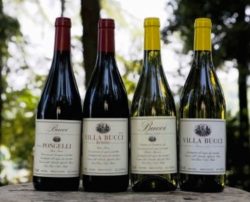
Originally from Montecarrato, the Bucci family has been working in agriculture since the 1700s. Today they grow on their estate organic grapes along with durum, common wheat, maize, sugarbeet, sunflowers and olive trees. Villa Bucci’s Verdicchio Classico Superiore dei Castelli di Jesi DOC (told you the vocab would come in handy!) is a solid wine.
Rules call for an 85% minimum of Verdicchio in Jesi DOC wines, and Bucci is a full 100%. It is a bright yellow with a green note and has a fruity, apple yet dry flavor profile. It goes well on its own as an aperitif or with seafood pastas, brodetto and fresh cheeses.
Up the ante: Try their Verdicchio Riserva DOCG Classico, which was rated in 2017 as the best Italian white wine by Daniele Cernilli and in 2013 received 93 points from Robert Parker.
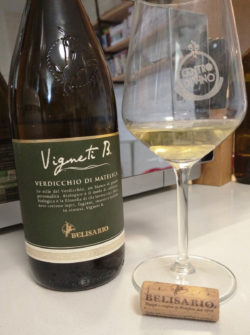 The production area of Verdicchio di Matelica is ten times smaller than Castelli di Jesi and has no direct connection with the sea. The area’s climate and soil are more continental, which explains why this version of Verdicchio smells and tastes
The production area of Verdicchio di Matelica is ten times smaller than Castelli di Jesi and has no direct connection with the sea. The area’s climate and soil are more continental, which explains why this version of Verdicchio smells and tastes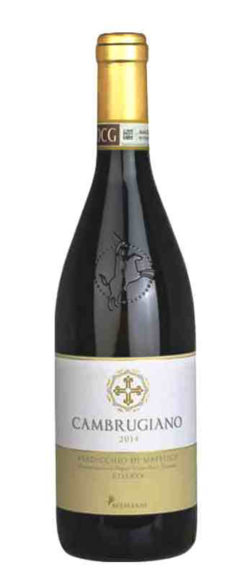 so distinctly. Verdicchio di Matelica tends to be more full-bodied, alcoholic and to my palate more metallic and mineral in flavor.
so distinctly. Verdicchio di Matelica tends to be more full-bodied, alcoholic and to my palate more metallic and mineral in flavor.
Just 30 miles south from Villa Bucci’s headquarters in Ostra Vetere is Cantina Belisario in Matelica. Cantina Belisario debuted Cambrugiano Verdicchio di Matelica DOCG Riserva in 1988. It too is made with 100% Verdicchio grapes and was rated by Daniele Cernilli in 2015 as the best verdicchio.
This more structured wine has a more prominent nose with floral and vanilla notes and a mineral quality. It pairs well with complex seafood dishes, poultry, pork and rabbit as well as semi-aged cheeses.
Drink Up North
White wines from Northern Italy range from Gewürtztraminers to the endless varietals of Friuli Venezia Giulia. In the category of dry whites made from a local cultivar, Soave is always a reliable choice. Despite its massive popularity in the United States in the late twentieth century – at a certain point it sold more than Chianti – it’s not the first Italian white wine you think of these days.
Soave DOC production is limited to an area east of Verona with Soave at its center. Garganega is the local grape the wine is made from – between 70 and 100%. It can be blended with Chardonnay, Pinot Bianco or Trebbiano di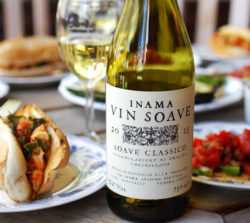 Soave, but if you want to taste what it can do on its own opt for Inama’s Vin Soave.
Soave, but if you want to taste what it can do on its own opt for Inama’s Vin Soave.
Giuseppe Inama started his winemaking business in 1948 and understood early on the importance of owning vineyards in Soave Classico territory. His son and grandchildren continue what he begun, producing fine classic and experimental wines. They aptly describe their Soave Classico DOC as “A little luxury for everyday”. Vin Soave is a dry, light yellow wine that is both mineral and floral. It goes well with vegetable courses, white fish, raw seafood, risottos and the local dish of cuttlefish with peas.
Up the ante: If you’re looking for a special wine with personality, Inama’s Vulcaia Fumé Sauvignon is worth your investigation.
Head South to Sardinia
Expand your taste bud travel with a white wine from Sardinia, the island south of Corsica and north of Tunisia. Its northern tip is home to the 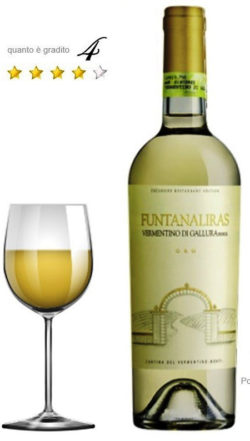 island’s only DOCG appellation, Vermentino di Gallura. Apparently dating back to the 1300s, the grape also appears under the name Arratelau. The wine must be made from at least 95% Vermentino grapes in an area surrounding Olbia in order to earn its DOCG stamp.
island’s only DOCG appellation, Vermentino di Gallura. Apparently dating back to the 1300s, the grape also appears under the name Arratelau. The wine must be made from at least 95% Vermentino grapes in an area surrounding Olbia in order to earn its DOCG stamp.
Cantina del Vermentino – Monti is a winemaking cooperative, a common collective format in Italy, France and Germany, in which members share ownership and pool their resources for wine production, bottling and marketing. Founded in 1956, Cantina del Vermentino now counts 350 members – vineyard owners who work across a territory of 500 hectares in Monti, Telti, Olbia, Loiri and Porto San Paolo.
Its signature wine is Funtanaliras. There are many Vermentino di Gallura, but this one is a great place to start because of its excellent quality at a very modest price point. Made from 100% Vermentino, it is a pale straw yellow with a flavor profile of apricot with a herbaceous aroma and a clean finish. You really can’t go wrong pairing it with any seafood or vegetable course, especially with a citrus angle.
In Vino Veritas
Use these recommendations for finding wines worth drinking. If the ones mentioned aren’t available, scout out other bottles of the same varietal. Poets, politicians, writers and philosophers of note have all had their say about the benefits of wine, but the quote to live by is anonymous: “Life is too short to drink bad wine.”

Juggling nuance between Italian and English, Tatiana lights up her five-burner kitchen top with nostalgia for American food, Bologna-inspired fare and cross-cultural inventions. She and her husband endlessly debate on cooking with or without a recipe. Their son just hopes that dinner will either be plain or have chocolate in it.




How can we find some of these in the DC area please?
Check with Calvert Woodley and Macarthur Beverages. Happy tasting!
In the Alexandria area, some of these wines are available through special order at Unwined. Contact Vanessa Moore for detailsunwinedalexandria@gmail.com
Nancy
Thank you for this. I’ve preferred drinking white wine for quite a few years now (red and I just aren’t good friends any more) but I’ve struggled finding ones that I like – bright, refreshing, not heavy or sweet. I had forgotten about Soave. I’ll be looking into these. Thanks again!
Hi Jennifer, you’re absolutely right about Soave being forgotten. It’s been a great rediscovery. Let us know what you’re drinking!
Thanks, Tatiana! We love Italian wines and have our sights set Italy for October 2021, fingers crossed we’ll make it. I am so glad your mom began this newsletter. We so enjoy our meals from Open Hand and all of her other tips and teachings.
Thanks for sharing Pat. It’s so uplifting to hear about people making plans to travel again! October is a great time to explore Italy with less heat and beautiful fall colors. I raise my glass to your adventure, and if you need any travel advice I’m happy to help.